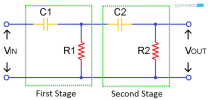Claude M
Inspired
Hi guys.
Can someone explain the following scenario to me coz I can't wrap my head around it.
The following scenario is from reading information and watching videos from well known (and not so well known) Fractal YouTubers.
"Nearly" everyone when setting up a preset, Low and Hi cuts the Cab block, say at 80-100HZ and 6500HZ (examples). But what I don't understand is what happens next. A lot of guys then also place a PEQ after the Cab block and the first thing they do is Type 1, Blocking at 100HZ at 12/24db. Then Type 5 Blocking at 6500HZ at 12/24 db. Then some use a Looper to sweep Type 2, 3 and 4 to cut frequencies that don't sound good.
Now I know that not everyone does this in their presets, but my question to this thread is:
If I've cut the Cab block at 100 and 6500 and then do the same cut in the PEQ block, aren't I doubling the 100 and 6500Hz cuts? Aren't I over EQing?
Thanks.
Can someone explain the following scenario to me coz I can't wrap my head around it.
The following scenario is from reading information and watching videos from well known (and not so well known) Fractal YouTubers.
"Nearly" everyone when setting up a preset, Low and Hi cuts the Cab block, say at 80-100HZ and 6500HZ (examples). But what I don't understand is what happens next. A lot of guys then also place a PEQ after the Cab block and the first thing they do is Type 1, Blocking at 100HZ at 12/24db. Then Type 5 Blocking at 6500HZ at 12/24 db. Then some use a Looper to sweep Type 2, 3 and 4 to cut frequencies that don't sound good.
Now I know that not everyone does this in their presets, but my question to this thread is:
If I've cut the Cab block at 100 and 6500 and then do the same cut in the PEQ block, aren't I doubling the 100 and 6500Hz cuts? Aren't I over EQing?
Thanks.



